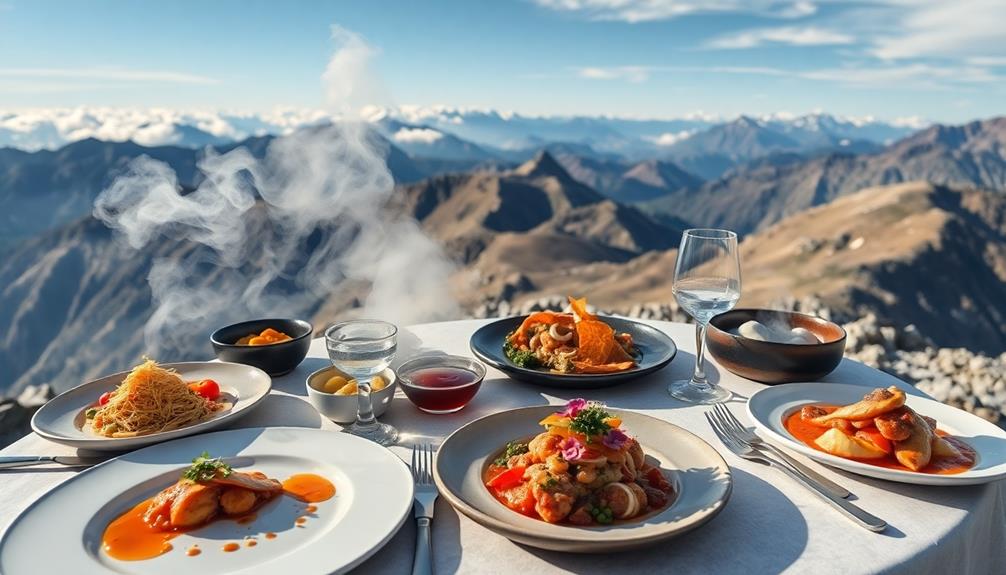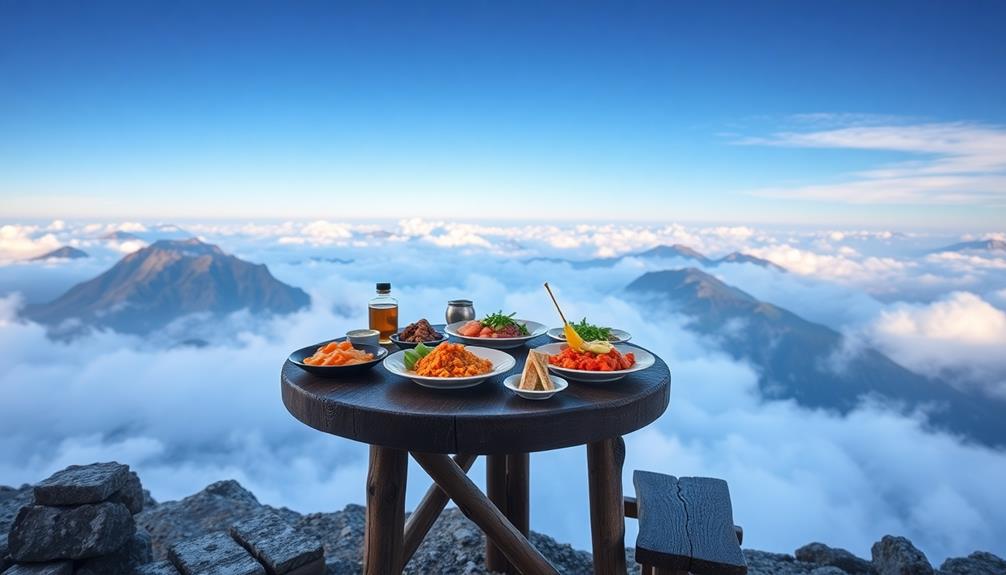Foods taste different at specific altitudes primarily because your taste perception changes. At high altitudes, lower oxygen levels and reduced atmospheric pressure can decrease your ability to taste, leading to about a 30% drop in flavor sensitivity. Sweet and salty flavors are hit the hardest, making meals less enjoyable. To compensate, chefs often enhance dishes with increased salt and sugar, especially in airline meals. Additionally, your familiarity with high altitude can improve your taste experience. Want to discover more about how altitude affects flavor and how chefs adapt meals for your enjoyment?
Key Takeaways
- Taste perception decreases at high altitudes, making certain foods with enhanced flavors more enjoyable.
- Sweet and salty flavors are less effective at altitude, while umami and sour flavors remain stable.
- Increased salt and sugar in meals can compensate for diminished taste sensitivity at high altitudes.
- Familiarity with altitude can enhance taste experiences, making some foods more appealing.
- Innovative culinary adaptations, such as collaborations with chefs, improve in-flight dining flavors.
Effects of Altitude on Taste

As you ascend to higher altitudes, you may notice that your sense of taste takes a hit. Research shows that at high altitudes, your taste perception can decrease by about 30%. Changes in atmospheric pressure and reduced oxygen levels play a big role in this decline. Sweet and salty flavors often suffer the most, leaving you with a less satisfying meal.
However, sour tastes tend to remain stable, while bitter flavors may even intensify. Curiously, foods with rich umami flavors, like ankimo (monkfish liver pâté), can provide a more enjoyable experience at high altitudes due to their depth of taste.
The dry air at high altitudes further complicates things, as it diminishes your sense of smell, which accounts for roughly 80% of your taste experience. This combination can really affect how you enjoy food. For example, coffee aromas and tomato juice flavors are significantly altered in high-altitude environments, making them less appealing.
Remarkably, the more time you spend at high altitudes, the more your taste perception can adapt. Familiarity with these conditions can enhance your overall taste experience, allowing you to enjoy food in ways you mightn't have expected.
Understanding these effects can help you choose meals that suit your palate when you find yourself at great heights.
Airline Menu Adaptations

Airline menus are carefully crafted to enhance your dining experience at high altitudes, where taste perception diminishes considerably. Traditional dishes like Red-Braised Pork Belly are often adapted to retain their rich flavors in the air.
Airline chefs, like those for British Airways, account for these effects by adjusting their recipes. They often increase salt and sugar to boost flavors while keeping hydration in mind. Studies show that your sense of taste drops by about 30% during flights, which is why umami flavors become vital. This has led airlines to incorporate umami-rich ingredients to elevate meal options.
JetBlue collaborates with restaurant Saxon+Parole to create dishes that emphasize acidity, heat, and umami, ensuring that your in-flight meals remain flavorful.
British Airways has also recognized the need for specialized meals with enhanced flavor profiles. They focus on ingredients that cater to your taste buds at high altitudes, making your experience more enjoyable.
Continuous research into how altitude impacts taste perception motivates these culinary strategies, allowing airlines to refine their menus. By understanding the science behind your dining experience, airlines aim to enhance passenger satisfaction during flights, ensuring you savor every bite, even at cruising altitude.
Innovative Culinary Collaborations

Innovative culinary collaborations are transforming in-flight dining by addressing the unique challenges posed by high altitudes. Airlines like JetBlue and British Airways are teaming up with celebrated chefs to enhance your dining experience.
For example, JetBlue partners with Saxon+Parole, focusing on balancing acidity, heat, and umami flavors to cater to your diminished sense of taste at high elevations. This approach is similar to how Brazilian dishes like Caldeirada utilize rich flavors and diverse ingredients to create a satisfying experience.
Chef Brad Farmerie creatively uses ingredients like chili marshmallows in carrot and ginger soup to keep flavors vibrant without relying on excessive salt.
British Airways collaborates with Heston Blumenthal to explore ingredient perception, ensuring that the food you enjoy in the sky remains flavorful despite altitude's effects.
Lufthansa's partnership with the Fraunhofer Institute brings a scientific approach to identifying ideal food pairings, enriching the flavor profiles of meals served during flights.
These innovative culinary approaches are essential for developing meals that remain enjoyable for you at high altitudes. By emphasizing umami flavors and carefully selecting spices, airlines are reshaping your in-flight dining experience, making it more satisfying and memorable.
As these collaborations grow, your taste buds will thank you for the elevated dining experiences.
Specialized Beverage Offerings

How can specialized beverages elevate your in-flight experience? Airlines are now focusing on crafting drinks that enhance your enjoyment of food at high altitudes.
For instance, British Airways teamed up with Brewdog to create Speedbird 100 beer, specifically brewed to boost flavor perception while you're soaring through the skies. Similarly, Cathay Pacific offers a unique beer, designed with special ingredients that perform better in the cabin environment.
Wines from high-altitude regions also stand out, as they often maintain their flavor integrity during flights, enhancing your overall dining experience.
You'll find that the taste of food is greatly influenced by your sense of smell, which can be diminished in the cabin. That's why airlines are continuously adapting their beverage selections, ensuring you have options that are appealing and enjoyable at cruising altitudes.
While champagne is a classic choice, it tends to lose its fizz quickly due to cabin pressure, affecting the overall drinking experience.
Choosing specialized beverages can make a significant difference, allowing you to savor every bite and sip, ultimately transforming your journey into a delightful culinary adventure.
Challenges in Flavor Enhancement

Steering through the challenges of flavor enhancement at high altitudes requires a thoughtful approach from culinary teams. Airlines, like British Airways, face the difficult task of making meals taste different while considering passenger hydration.
At high altitudes, increased salt and sugar can lead to dehydration, forcing chefs to balance flavor without compromising wellness.
Unfortunately, there aren't any formal recipes designed specifically for in-flight meals, which complicates the process. Culinary teams must also cater to a variety of dietary restrictions and preferences, making it even tougher to create universally appealing menus.
The diminished taste sensitivity you experience at altitude means that typical flavor profiles may not register as intended. This calls for innovative menu planning strategies that enhance flavor without overwhelming the palate.
Continuous research is essential to understand how altitude impacts flavor perception, providing the necessary insights to improve your in-flight dining experience.
Ultimately, the challenge lies in crafting meals that remain enjoyable and memorable, ensuring that each bite resonates even when you're miles above the ground.
Frequently Asked Questions
Why Does Food Taste Different at Different Altitudes?
Food tastes different at various altitudes because changes in atmospheric pressure affect your taste buds and sense of smell. You might find certain flavors less intense, while others, like bitterness, can become more pronounced.
Does Food Cook Differently at High Altitude?
Yes, food cooks differently at high altitudes. You'll notice longer cooking times and adjustments needed for recipes. Lower boiling temperatures affect textures, and you might need to modify ingredients to achieve the desired results.
What Foods Are Good to Eat at High Altitude?
When you're at high altitude, opt for hydrating foods like soups and stews. Nutrient-dense snacks, such as trail mix and energy bars, keep your energy up. Enjoy fruits for their enhanced sweetness; they'll taste amazing!
Why Does Food Taste Different in the Sky?
When you eat in the sky, lower pressure and humidity affect your taste buds. You'll notice flavors shift; sweet and salty might fade, while umami could pop, altering your overall dining experience during flights.
Conclusion
To wrap it up, eating at higher altitudes transforms flavors in ways you wouldn't believe! The reduced pressure and humidity can dull your taste buds, making some foods taste bland. Airlines have adapted their menus to combat this, collaborating with chefs to enhance flavors. Plus, specialized beverages can elevate your experience even more. So, next time you're soaring through the skies, remember that altitude can turn your meal into a culinary adventure that's nothing short of extraordinary!










